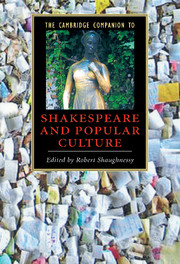Book contents
- Frontmatter
- Introduction
- 1 From popular entertainment to literature
- 2 Shakespeare abbreviated
- 3 Shakespearean stars: stagings of desire
- 4 Shakespeare illustrated
- 5 Shakespeare: myth and biographical fiction
- 6 Narration and staging in Hamlet and its afternovels
- 7 Shakespeare serialized: An Age of Kings
- 8 Musical Shakespeares: attending to Ophelia, Juliet, and Desdemona
- 9 Shakespeare overheard: performances, adaptations, and citations on radio
- 10 Shakespeare on the tourist trail
- 11 Performing Shakespeare in digital culture
- 12 Shakespeare’s popular face: from the playbill to the poster
- Further reading
- Index
- Series List
3 - Shakespearean stars: stagings of desire
Published online by Cambridge University Press: 28 November 2008
- Frontmatter
- Introduction
- 1 From popular entertainment to literature
- 2 Shakespeare abbreviated
- 3 Shakespearean stars: stagings of desire
- 4 Shakespeare illustrated
- 5 Shakespeare: myth and biographical fiction
- 6 Narration and staging in Hamlet and its afternovels
- 7 Shakespeare serialized: An Age of Kings
- 8 Musical Shakespeares: attending to Ophelia, Juliet, and Desdemona
- 9 Shakespeare overheard: performances, adaptations, and citations on radio
- 10 Shakespeare on the tourist trail
- 11 Performing Shakespeare in digital culture
- 12 Shakespeare’s popular face: from the playbill to the poster
- Further reading
- Index
- Series List
Summary
I begin with the desire to see Michael Gambon play Falstaff – a desire initiated by memories of his past performances and fueled by Michael Cordner's description of a South Bank Show's fly-on-the-wall recording of rehearsing 1 Henry IV's great tavern scene:
Gambon [is] playful and full of power . . . When recounting how he had dispatched in one fell swoop a posse of nocturnal attackers, he adroitly spears several with his sword, then spins on his foot and immobilizes another with a back-kick, spins again and repeats the trick in a different direction, then kills a few more with his sword before continuing blithely with his narrative. (He has obviously been studying films like Hero, House of Flying Daggers, and indeed Kill Bill.)
Dancing the role, inflecting Falstaff with movements borrowed from Asian warrior figures in recent award-winning films, writing Jet Li, Lucy Liu, or Uma Thurman over “Shakespeare,” adapting the part, one might say, to contemporary understanding or popular taste. (Gambon: “I try to move like a dancer. If I had been born again . . . I would be a ballet dancer.”) Whether or not these moves travel from rehearsal to performance, I anticipate a Falstaff so light on his feet that he makes me want to dance with him, a Falstaff performed by the actor Ralph Richardson dubbed “The Great Gambon” and whom Deborah Warner called “heavenly, super great.” A star, yes, but is Gambon a Shakespearean star? He has played Macbeth, Othello, King Lear, and Antony, but he probably is better known - in the sense of being “popular” - for The Singing Detective's Philip Marlow (1986), Inspector Maigret (1993-94), Lyndon Johnson in Path to War (2002), Dumbledore in Harry Potter and the Prisoner of Azkaban (2004), or even the voice of the washing machine in a Wisk television commercial. Does the starring role “make” the Shakespearean star actor?
- Type
- Chapter
- Information
- Publisher: Cambridge University PressPrint publication year: 2007
- 3
- Cited by

